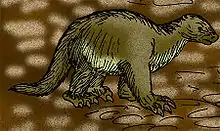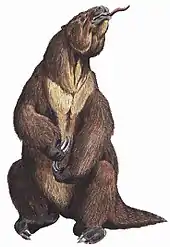Megalocnidae
Megalocnidae is an extinct family of sloths, known from the Greater Antilles from the Early Miocene to the Mid-Holocene. They are known from Cuba, Hispaniola and Puerto Rico, but are absent from Jamaica. While they were formerly placed in the Megalonychidae alongside two-toed sloths and ground sloths like Megalonyx, recent mitochondrial DNA and collagen sequencing studies place them as basal to all other sloths.[1][2] They displayed significant diversity in body size and lifestyle, with Megalocnus being terrestrial and probably weighing several hundred kilograms, while Neocnus was likely arboreal and similar in weight to extant tree sloths, at less than 10 kilograms.[3]
| Megalocnidae | |
|---|---|
 | |
| Megalocnus rodens, an extinct Cuban megalocnid sloth (AMNH) | |
| Scientific classification | |
| Kingdom: | Animalia |
| Phylum: | Chordata |
| Class: | Mammalia |
| Order: | Pilosa |
| Suborder: | Folivora |
| Family: | †Megalocnidae Presslee et al, 2019 (as family) |
| Genera | |
| |
| Synonyms | |
|
Megalocnoidea Delsuc et al, 2019 | |
Origin

It is thought that sloths arrived in the Caribbean from South America (where they arose) around the Eocene-Oligocene boundary about 33 Ma ago, when there was a significant sea level drop caused by a glaciation episode.[4] This has been associated with the GAARlandia (Greater Aves Antilles Ridge) hypothesis, where the Aves Ridge formed a land bridge during the interval, allowing overland migration into the Greater Antilles. The existence of such a land bridge has been questioned because of the lack of geological evidence for the Aves Ridge having been subaerially exposed[5] as well as the fact that many other South American animals (such as marsupials and ungulates) are absent from the Greater Antilles, making a complete land bridge unlikely.[3][note 1] The earliest evidence suggesting the presence of sloths in the Caribbean is a partial femur from the Early Oligocene of Puerto Rico.[6] More definitive remains are known for Imagocnus from Early Miocene Cuba.[7]
Taxonomy
The taxonomy of Caribbean sloths is in flux, with the number of species present among the Pleistocene-Holocene taxa in question; some species are likely junior synonyms, while the diversity of some genera is probably understated.[8] The mitochondrial DNA study suggests that Acratocnus ye and Parocnus serus are deeply divergent from each other, having split during the Oligocene, suggesting an early radiation within the group; they proposed the families Acratocnidae and Parocnidae within a new superfamily, Megalocnoidea.[1]
Based on White and MacPhee (2001):[9]
- Megalocnus
- †M. rodens Pleistocene to Holocene of Cuba.
- M. zile junior synonym of Parocnus serus[8]
- Acratocnus
- †A. odontrigonus Pleistocene of Puerto Rico
- †A. ye Pleistocene to Holocene of Hispaniola
- †A. antillensis Pleistocene to Holocene of Cuba
- Parocnus
- †Parocnus browni Pleistocene to Holocene of Cuba
- †Parocnus serus Pleistocene to Holocene of Hispaniola
- Neocnus
- †N. gliriformis Pleistocene to Holocene of Cuba
- †N. major Pleistocene to Holocene of Cuba
- †N. comes Pleistocene to Holocene of Hispaniola
- †N. dousman Pleistocene to Holocene of Hispaniola
- †N. toupiti Pleistocene to Holocene of Hispaniola
- Imagocnus
- I. zazae Early Miocene of Cuba
Paulocnus from Pliocene - Early Pleistocene deposits in Curaçao has been suggested to be part of Megalonychidae while Megalocnidae was considered part of the group, its location close to mainland South America and considerable displacement from the Greater Antilles make referral to Megalocnidae questionable.
For other sloth taxa of the Caribbean, see Pilosans of the Caribbean.
Phylogeny
The following sloth family phylogenetic tree is based on collagen and mitochondrial DNA sequence data (see Fig. 4 of Presslee et al., 2019).[2]
| Folivora |
| |||||||||||||||||||||||||||||||||||||||||||||||||||||||||||||||||
Extinction
Sloths in the Caribbean survived about 5000 years longer than ground sloths on the mainland. On Cuba the latest date for Megalocnus is calibrated 4700 BP.[10] while dates for Parocnus browni are around 6250 BP. On Hispaniola the dates for some indeterminate sloth specimens are around 5000 BP; these dates roughly coincide with the first settlement of the Caribbean, which suggests that humans were the cause of the extinction.[11]
Notes
- The main groups of terrestrial mammals to colonize the Antilles, sloths, caviomorph rodents and platyrrhine monkeys, have all displayed a facility for oceanic dispersal or island hopping in other settings. For example, megalonychid and mylodontid ground sloths reached North America from South America prior to formation of a complete land bridge, and both caviomorphs and platyrrhines originally reached South America by rafting across the Atlantic from Africa.
References
- Delsuc, F.; Kuch, M.; Gibb, G.C.; Karpinski, E.; Hackenberger, D.; Szpak, P.; Martínez, J.G.; Mead, J.I.; McDonald, H.G.; MacPhee, R.D.E.; Billet, G. (June 2019). "Ancient Mitogenomes Reveal the Evolutionary History and Biogeography of Sloths". Current Biology. 29 (12): 2031–2042.e6. doi:10.1016/j.cub.2019.05.043. PMID 31178321.
- Presslee, S.; Slater, G.J.; Pujos, F.; Forasiepi, A.M.; Fischer, R.; Molloy, K.; Mackie, M.; Olsen, J.V.; Kramarz, A.; Taglioretti, M.; Scaglia, F. (July 2019). "Palaeoproteomics resolves sloth relationships". Nature Ecology & Evolution. 3 (7): 1121–1130. doi:10.1038/s41559-019-0909-z. PMID 31171860.
- Defler, Thomas (2019), "Mammalian Invasion of the Caribbean Islands", History of Terrestrial Mammals in South America, Topics in Geobiology, 42, Springer International Publishing, pp. 221–234, doi:10.1007/978-3-319-98449-0_11, ISBN 978-3-319-98448-3, OCLC 1086356172
- Houben, A.J.P.; van Mourik, C.A.; Montanari, A.; Coccioni, R.; Brinkhuis, H. (June 2012). "The Eocene–Oligocene transition: Changes in sea level, temperature or both?". Palaeogeography, Palaeoclimatology, Palaeoecology. 335–336: 75–83. Bibcode:2012PPP...335...75H. doi:10.1016/j.palaeo.2011.04.008.
- Ali, Jason R. (March 2012). "Colonizing the Caribbean: is the GAARlandia land-bridge hypothesis gaining a foothold?: Commentary". Journal of Biogeography. 39 (3): 431–433. doi:10.1111/j.1365-2699.2011.02674.x.
- MacPhee, R.D.E.; Iturralde-Vinent, M.A. (1995). "Origin of the Greater Antillean land mammal fauna, 1: New Tertiary fossils from Cuba and Puerto Rico". American Museum Novitates. 3141: 1–31. hdl:2246/3657.
- MacPhee, R.D.E.; Iturralde-Vinent, M.A. & Gaffney, E.S. (2003). "Domo de Zaza, an early Miocene vertebrate locality in south-central Cuba, with notes on the tectonic evolution of Puerto Rico and the Mona Passage". American Museum Novitates. 3394: 1–42. doi:10.1206/0003-0082(2003)394<0001:DDZAEM>2.0.CO;2. hdl:2246/2820.
- McAfee, R.K.; Beery, S.M. (2019-06-04). "Intraspecific variation of Megalonychid sloths from Hispaniola and the taxonomic implications". Historical Biology: 1–16. doi:10.1080/08912963.2019.1618294.
- White, J.L.; MacPhee, R.D.E. (2001). "The sloths of the West Indies: a systematic and phylogenetic review". In Woods, C. A.; Sergile, F. E. (eds.). Biogeography of the West Indies: Patterns and Perspectives. Boca Raton, London, New York, and Washington, D.C.: CRC Press. pp. 201–235. doi:10.1201/9781420039481-14. ISBN 978-0-8493-2001-9.
- MacPhee, R. D. E.; Iturralde-Vinent, M. A.; Vázquez, Osvaldo Jiménez (January 2007). "Prehistoric Sloth Extinctions in Cuba: Implications of a New "Last" Appearance Date". Caribbean Journal of Science. 43 (1): 94–98. doi:10.18475/cjos.v43i1.a9. ISSN 0008-6452.
- Steadman, D. W.; Martin, P. S.; MacPhee, R. D. E.; Jull, A. J. T.; McDonald, H. G.; Woods, C. A.; Iturralde-Vinent, M.; Hodgins, G. W. L. (2005-08-16). "Asynchronous extinction of late Quaternary sloths on continents and islands". Proceedings of the National Academy of Sciences. 102 (33): 11763–11768. Bibcode:2005PNAS..10211763S. doi:10.1073/pnas.0502777102. ISSN 0027-8424. PMC 1187974. PMID 16085711.

